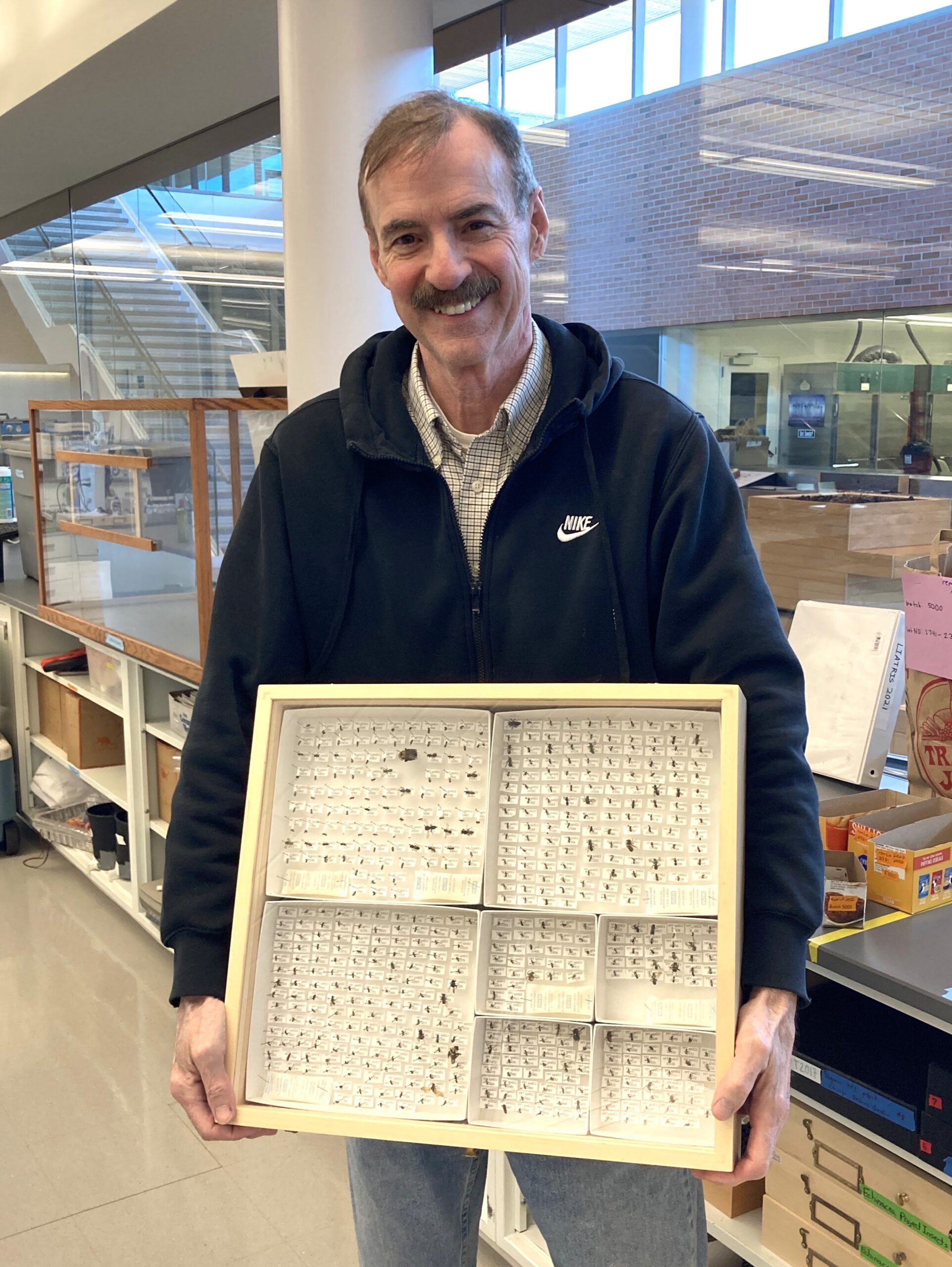In 2023, Team Echinacea did not conduct any fieldwork for this experiment.
Pollinator populations are declining worldwide, and pollinator habitat in western Minnesota has diminished over the years, but it is unclear whether the native bee community is changing as well. The Pollinators on Roadsides project, also known as the Yellow Pan Trap (YPT) study, is investigating how native bee diversity and abundance have changed from 2004-2022 and learning about whether the amount of agricultural land and grassland correspond to the nearby bee community.
In the lab, rock star pinner and volunteer Mike Humphrey finished pinning all 789 bees from 2022 on 6 April, 2023. Intern Alex Carroll brought the bees to Zach Portman, the bee taxonomist at the University of Minnesota, for identification on 6 June, 2023. Zach recently reported that he’s all done with our 2022 bees, and we will be picking them up from UMN next chance we get!

Alex worked to put datasets together (view in Dropbox/ypt2004in2017/yptDatasets/) for this experiment to prepare us for when Zach finishes his identifications. Alex also created this to-do list of next steps:
- When Zach finishes identifying the 2022 specimens, fill in zachGenus, zachSpecies, and zachSex for 2022 spids.
- Remove 2022 spids that are nonbees.
- Update 2017 collectDate. In 2017, traps were put out one day and then collected the next day.
Some of the 2017 dates are the day the trap was put out and some are the collection day. These should be standardized.
MAS figured out most of the timeline here: ypt2004in2017/yptDataAnalysis2022/collectionDatesAndMowedTraps/2017listOfCollectionDatesAndMowedTraps-11-May-2022.csv
These dates are based on the 2017 summer datasheets: ypt2004in2017\YPT2017\YPTsummer2017\ypt2017FieldDatasheets.pdf - Locate missing trap numbers for 35 bees, all collected on 07/26/2004.
There is a memo for half of the traps collected on 07/26/2004, but half (the outerloop) are missing.
See ypt2004in2017/YPT2004/yptMemos2004/ypt04-js.doc - Determine what to do about missing specimens.
Some specimens were identified by Sam Drogee in the past, but we couldn’t find the bee.
SW remembers that Sam took some specimens, so he may still have them.
A few specimens have gone missing. See the notes column.
Summary
- Start year: 2004, rebooted in 2017
- Location: Roadsides and ditches around Solem Township, Minnesota. GPS coordinates for each trap are located here: ~Dropbox\teamEchinacea2022\YPTsummer2022\yptTrapLocations2022.csv
- Overlaps with: Ground nesting bees
- Data collected: All YPT data can be found in ~Dropbox\ypt2004in2017
- Most recent update on state of data/experiment, including metadata and to-do list: Dropbox/ypt2004in2017/yptDatasets/readMe.txt
- Most current YPT specimen data with Zach’s IDs
- Dropbox/ypt2004in2017/yptDatasets/yptDataIncludingNonbees2023.10.25.csv
- Dropbox/ypt2004in2017/yptDatasets/yptDataBeesOnly2023.10.25.csv
- Specimens collected:
- Zach Portman identified all specimens from 2004-2019, and the specimens are stored in eight cases at the CBG lab.
- Mike finished pinning specimens from 2022 on April 6th, 2023. Alex delivered 2 cases of specimen to Zach on June 6th 2023. A little over a month ago, Zach said he had a backlog and wouldn’t get to them for a month. So, hopefully he’ll be working on them soon!
- Team members involved with this project: Geena Zebrasky (2022), Mia Stevens (2020-2023), Alex Carroll (2021-2023), Erin Eichenberger (2019-2020), Anna Stehlik (2020), Shea Issendorf (2019), Mike Humphrey (2018-2021), John Van Kampen (2018-2019), Kristen Manion (2017-2018), Evan Jackson (2018), Alex Hajek (2017), and Steph Pimm Lyon (2004)
- Products: Mia and Alex presented preliminary results at the Midwest Ecology and Evolution Conference (MEEC) and at The Prairie Enthusiasts (TPE) conference in spring 2022.
Funding for this project was provided by the Minnesota Environment and Natural Resources
Trust Fund as recommended by the Legislative-Citizen Commission on Minnesota Resources
(LCCMR). The Trust Fund is a permanent fund constitutionally established by the citizens of Minnesota to assist in the protection, conservation, preservation, and enhancement of the state’s air, water, land, fish, wildlife, and other natural resources. Currently 40% of net Minnesota State Lottery proceeds are dedicated to growing the Trust Fund and ensuring future benefits for Minnesota’s environment and natural resources.
You can read more information about the pollinators on roadsides project here.

Leave a Reply